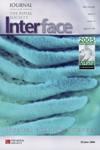Forschung // 6. Juni 2006
Wet but not slippery: boundary friction in tree frog adh. pads
W. Federle A1 A2, W.J.P. Barnes A3, W. Baumgartner A4, P. Drechsler A1 A2, J.M. Smith A3
A1 University of Cambridge Department of Zoology Cambridge CB2 3EJ, UK
A2 University of Würzburg Zoology II Biozentrum, 97074 Würzburg, Germany
A3 Institute of Biomedical and Life Sciences, University of Glasgow Division of Environmental and Evolutionary Biology Glasgow G12 8QQ, UK
A4 Institute of Biology 2 Department of Cellular Neurobionics RWTH-Aachen, 52056 Aachen, Germany
Abstract:
Tree frogs are remarkable for their capacity to cling to smooth surfaces using large toe pads. The adhesive skin of tree frog toe pads is characterized by peg-studded hexagonal cells separated by deep channels into which mucus glands open. The pads are completely wetted with watery mucus, which led previous authors to suggest that attachment is solely due to capillary and viscous forces generated by the fluid-filled joint between the pad and the substrate. Here, we present evidence from single-toe force measurements, laser tweezer microrheometry of pad mucus and interference reflection microscopy of the contact zone in Litoria caerulea, that tree frog attachment forces are significantly enhanced by close contacts and boundary friction between the pad epidermis and the substrate, facilitated by the highly regular pad microstructure.


